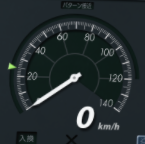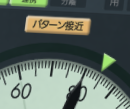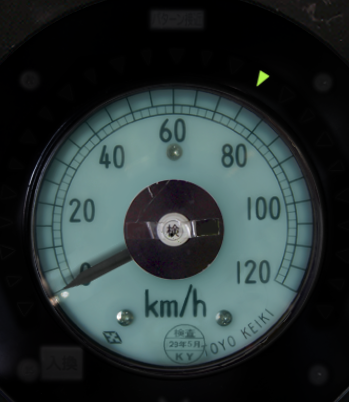Safety Systems
Note : pressing the "ATS Reset" or alarm stop buttons is not necessary if "ATS Brake Reset" is set to automatic in the settings. The same applies to the "ATS Confirmation" button, if "ATS Confirmation" is set to automatic.
ATS-S
The ATS-S is one of the first safety systems to automatically stop a train as it approaches a stop signal (red light). It operates by means of transponders located between the rails, a few hundred meters before the stop signal.
When the train passes over the transponder and the next signal is a stop signal, a buzzer sounds, along with a "ding dong". You then have 5s to start braking and press the "ATS Confirmation" button (Space key). The ringing will stop, but the "ding dong" will continue to sound. Once stationary, you can press the alarm stop button (X key) to stop the alarm.
However, if you don't brake and confirm within 5 seconds, the train will stop automatically. Once at a standstill, you'll need to put the brakes in the EB emergency brake position, then press the "ATS Reset (Emergency)" button (U button) to disengage the emergency brake, so you can continue driving to position your train.
As this may not be enough to prevent the driver, after confirmation, from passing the stop signal, another transponder has been added just after the end of the platform. If the train passes this and the stop signal is present, an emergency brake is also applied, and you will need to perform the same operation as in the previous paragraph.
ATS-P
ATS-P is a system that no longer relies on driver confirmation (as with ATS-S), but on braking curves (patterns) generated when approaching a dangerous curve or stop signal. The ATS-P is represented by an analog or digital panel (depending on the train) with 6 or 7 indicators (whether there is a service brake/emergency brake distinction or not).
When a pattern is generated and the train approaches the maximum speed generated by this pattern, the "Pattern approach" indicator lights up and a "ding" is emitted to warn the driver to reduce speed.
Apart from approaching a stop signal, if the train exceeds the maximum speed authorized by the pattern, the ATS-P will automatically activate the train's brakes to bring it back under the limit. When braking, the "Service brake" or "Brake operation" indicator lights up and a "ding" sounds, until the train drops below the pattern's speed limit.
However, when approaching a stop signal (red light), if the speed limit is exceeded, the ATS-P will bring the train to a complete stop using the service brake ("Service brake" or "Brake operation" indicator). In this case, once at a standstill, you need to set the brakes to levels B1 to B8, then press the "ATS Reset (Service)" button (key Y) to disengage the brakes and continue driving to position your train.
Finally, if you are about to pass the stop signal by crossing the transponder closest to the stop signal (usually at the end of the platform), the ATP-P will perform an emergency brake (indicator "Emergency brake" or "Brake operation"). Once stationary, you must set the brakes in emergency position, then press the "ATS Reset (Emergency)" button (key U) to disengage the emergency brake, so that you can position your train properly.
Here's the list of indicator lights for each dial version:
| Without service/emergency brake distinction |
With service/emergency brake distinction |
|
|
 |
They are sometimes also followed by the 2 following indicators:
|
|
ATS-Ps
The ATS-Ps is an improved ATS-S, incorporating the functionality of the former (see above) and adding a system for generating braking patterns to force the train not to exceed certain limits (generally before dangerous curves or switches). The ATS-Ps is represented in the cab by a dial containing a gauge and several indicators. On the gauge, the green part represents the current speed and the yellow part the limit not to be exceeded.
When a pattern is generated, the "Pattern generation" or "ATS-Ps" green indicator lights up and an audible announcement is made. From then on, the yellow part of the gauge will increase. If you're too close to the limit, the "Pattern approach" light, in orange, will light up and a little buzzer sound will be emitted to warn you to brake.
If, however, the limit is reached, the "Brake operation" indicator, in orange, will light up and the train will stop automatically. Once stopped, you'll need to apply the emergency brakes, then press the "ATS Reset (Emergency)" button (U key) to restart.
Here's the list of indicator lights for each dial version:
|
ATS-Ps version |
ATS-P/Ps version |
 |
 |
|
|
D-ATC
The D-ATS (for Digital Automatic Train Control) is a speed control system and a modernized version of the old analog ATC systems. This was originally developed for Shinkansen (Japanese high-speed trains) because, at high speed, drivers had no time to take note of signals on the track.
This system uses information transmitted by track circuits, as well as information stored in the on-board computer's memory, to keep the train and its driver aware of possible events ahead of the train (tight curve, presence of a train in the next block, etc.).
 For trains using the D-ATC safety system, maximum speed is represented by a green arrow on the speed dial. If the maximum speed is exceeded, the train will automatically brake more or less hard to go below the limit.
For trains using the D-ATC safety system, maximum speed is represented by a green arrow on the speed dial. If the maximum speed is exceeded, the train will automatically brake more or less hard to go below the limit.

When changing speed limit, a bell sound is emitted. If the change involves a reduction in speed, the maximum speed indicator will move slowly. If the indicator above the speed dial (パターン接近 / pattern approach) is lit, then you will need to slow down until it goes out.
ATACS

ATACS works in much the same way as D-ATC, except that information is transmitted via a radio signal and not via track circuits.

